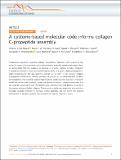| dc.contributor.author | DiChiara, Andrew Stephen | |
| dc.contributor.author | Li, Rasia C. | |
| dc.contributor.author | Suen, Patreece H. | |
| dc.contributor.author | Hosseini, Azade S. | |
| dc.contributor.author | Taylor, Rebecca J. | |
| dc.contributor.author | Weickhardt, Alexander F. | |
| dc.contributor.author | Malhotra, Diya | |
| dc.contributor.author | Shoulders, Matthew D. | |
| dc.date.accessioned | 2020-05-28T17:31:58Z | |
| dc.date.available | 2020-05-28T17:31:58Z | |
| dc.date.issued | 2018-10 | |
| dc.identifier.issn | 2041-1723 | |
| dc.identifier.uri | https://hdl.handle.net/1721.1/125561 | |
| dc.description.abstract | Fundamental questions regarding collagen biosynthesis, especially with respect to the molecular origins of homotrimeric versus heterotrimeric assembly, remain unanswered. Here, we demonstrate that the presence or absence of a single cysteine in type-I collagen’s C-propeptide domain is a key factor governing the ability of a given collagen polypeptide to stably homotrimerize. We also identify a critical role for Ca2+ in non-covalent collagen C-propeptide trimerization, thereby priming the protein for disulfide-mediated covalent immortalization. The resulting cysteine-based code for stable assembly provides a molecular model that can be used to predict, a priori, the identity of not just collagen homotrimers, but also naturally occurring 2:1 and 1:1:1 heterotrimers. Moreover, the code applies across all of the sequence-diverse fibrillar collagens. These results provide new insight into how evolution leverages disulfide networks to fine-tune protein assembly, and will inform the ongoing development of designer proteins that assemble into specific oligomeric forms. | en_US |
| dc.description.sponsorship | National Science Foundation (U.S.) (Grant NSF-0070319) | en_US |
| dc.description.sponsorship | National Science Foundation (U.S.). Center for Science of Information (Grant P30-ES002109) | en_US |
| dc.description.sponsorship | National Institutes of Health (U.S.) (Grant R03AR067503) | en_US |
| dc.description.sponsorship | National Institutes of Health (U.S.) (Grant 1R01AR071443) | en_US |
| dc.description.sponsorship | National Institutes of Health (U.S.). Ruth Kirschstein Predoctoral Fellowship (1F31AR067615) | en_US |
| dc.language.iso | en | |
| dc.publisher | Springer Science and Business Media LLC | en_US |
| dc.relation.isversionof | https://dx.doi.org/10.1038/S41467-018-06185-2 | en_US |
| dc.rights | Creative Commons Attribution 4.0 International license | en_US |
| dc.rights.uri | https://creativecommons.org/licenses/by/4.0/ | en_US |
| dc.source | Nature | en_US |
| dc.title | A cysteine-based molecular code informs collagen C-propeptide assembly | en_US |
| dc.type | Article | en_US |
| dc.identifier.citation | DiChiara, Andrew S. et al. “A cysteine-based molecular code informs collagen C-propeptide assembly.” Nature Communications 9 (2018): 4206 © 2018 The Author(s) | en_US |
| dc.contributor.department | Massachusetts Institute of Technology. Department of Chemistry | en_US |
| dc.contributor.department | McGovern Institute for Brain Research at MIT | en_US |
| dc.relation.journal | Nature Communications | en_US |
| dc.eprint.version | Final published version | en_US |
| dc.type.uri | http://purl.org/eprint/type/JournalArticle | en_US |
| eprint.status | http://purl.org/eprint/status/PeerReviewed | en_US |
| dc.date.updated | 2020-01-08T16:57:30Z | |
| dspace.date.submission | 2020-01-08T16:57:32Z | |
| mit.journal.volume | 9 | en_US |
| mit.metadata.status | Complete | |
